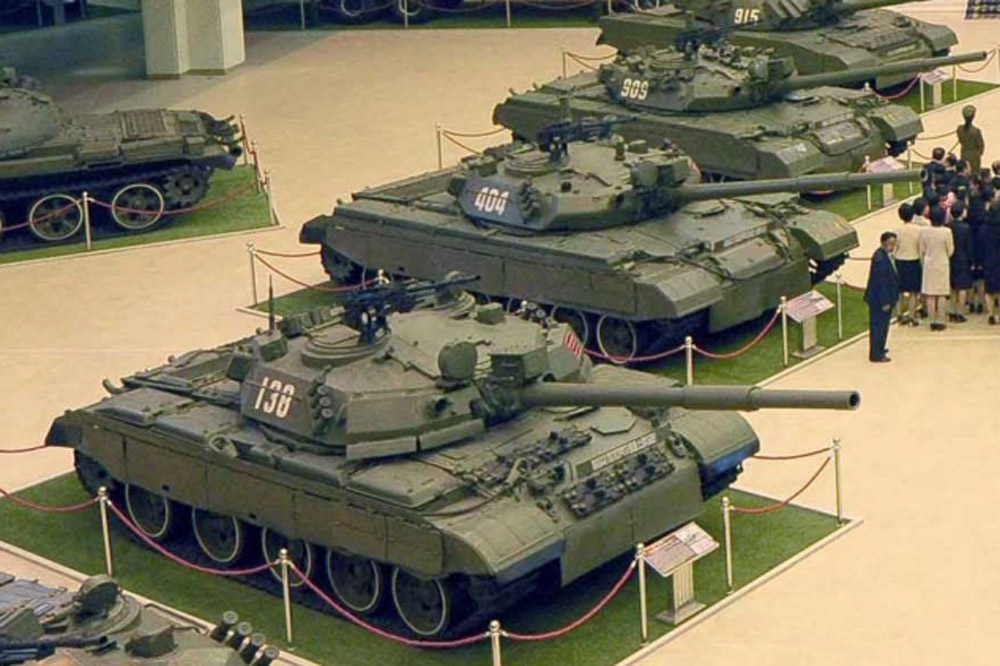
Pokpung-ho(Chonma-215 and -216)By Massimo Tessitori |
Pokpung-ho, which means "Storm Tiger" in Korean, (the suffix 'ho' means 'model, type', and is optional in the designation.) is the name given by the US DoD to a tank that North Koreans call 'Chonma-215' if armed with the usual 115 mm gun, or 'Chonma-216' if armed with the more powerful 125 mm gun. Another name used outside is M-2002, because the tank went through performance trials in February 2002.
The tank is thought to have utilized some technologies from Soviet tanks as T-72, T-80 and T-90 trying to fill the gap between their older tanks and the South Korean K1, whose performances were similar to that of early versions of M1. Anyway, probably the inspiration was very superficial, limited to the 125 mm gun (but without autoloader) of the second version, to the use of six road wheels instead of five and to some protections. The tank remains fundamentally a grown-up and angular T-62.
The first Pokpung-ho is believed to have been produced in 1992 in the Ryu Kyong-su Tank Factory, located in Sinhung, South Hamgyong Province. The capabilities of later variants have been augmented significantly. Because of North Korea's limited industrial capability, and the priority given to the nuclear program, North Korea was believed to possess less than 250 Pokpung-ho in 2007. However, production seems to have picked up starting in 2010.
The tank was witnessed by parties outside of North Korea in 2002 and thus codenamed the M-2002. It was shown to the public during a North Korean parade in 2010, as well as during military exercises in 2012.
Its primary armament is almost certainly the 115 mm 2A20 in early examples; however, later versions seemed to be armed with the 2A26/2A46 125mm smoothbore gun which fires AP rounds produced in North Korea. The tank also has a heavy KPV anti-aircraft machine gun and a coaxial machine gun, as well as four smoke grenade launchers on the each side of the turret.
The chassis of the Pokpung-ho is similar to that of a T-62, but are heavily modified with greater length and an additional pair of roadwheels.
The engine power is thought to be around 1000-1100 hp, and the total weight about 44 ton; this would give the tank a good agility, with a higher power for ton than the T-62.The Fire Control System of the P'okp'ung-ho is relatively modern and based on the presence of a meteorological mast is almost certainly computerized, and some reports claim that it may be based on the possibly superior, if aging Chieftain FCS, which Iran may have illegally exchanged for North Korean Technology. If the P'okp'ung-ho's FCS is based on the T-72's, it may implement the PNK-3 or PNK-4 day and night sighting system with the 1K13-49 periscope combined passive/active sight guidance system.
The P'okp'ung-ho also has an infrared sensor (TPN-3-49 or TPN-4), a laser rangefinder and a search light, all of which allow to operate during the night.
Although the quality is likely inferior to the South Korean counterparts, the Pokpung-ho is thought as a considerable threat at medium/short range; anyway, apart for the likely inferior performance of optics, FCS, gun and armour, we have also to take into account the limitations to elevation and depression of the main gun, typical of T-62 and likely worsened in the last version with 125 mm gun; this could become a problem on mountain ground, preventing to aim a target in too high or too low position; for comparison, South Korean K1 family has hydraulically adjustable suspensions able to change the inclination of the tank, and then allowing to gain more elevation and depression for the main gun.

The comparison shows:
Pokpung-Ho I is the initial variant, armed with the 115 mm 2A20 gun from the T-62 series and equipped with applique and spaced armor. First observed publicly during the spring of 2010. Clicking on the image aside, you can enlarge the photo of Chonma-215 to try to see some details of the hull deck. |
|
| A closer detail of the turret of Pokpung-ho I (Chonma-215), recognizable
for the smoke mortars in one column. We can see a cylindrical device on the roof, aside the T-62 style night optics. |
|
| Front view of Pokpung-ho II (Chonma 216), recognizable for the
two columns smoke mortar disposition, probably photographed during the
2010 parade. The additive armour on the front glacis is particularly well visible. The smoke mortars arrangement of this tank allows to Note the tracks, still similar to those of Chonma-214 and 215: similar to those of T-62 but equipped with rubber blocks, at least when moving on the streets. |
|
| An image from the left side of Pokpung-ho II. It's still unclear if
the road wheels are of the same diameter of previous models, or slightly
smaller.It's likely that the track is sustained by 3 rollers as on the
Songun-ho derivative, but the detail is hidden by the skirts. Below: a detail of the installation of the KPV 14.5 mm machine gun; the photo seems to represent a Songun-ho, but the weapon is the same. from http://www.armyrecognition.com/index.php |
|
|
Another Chonma-ho II. |
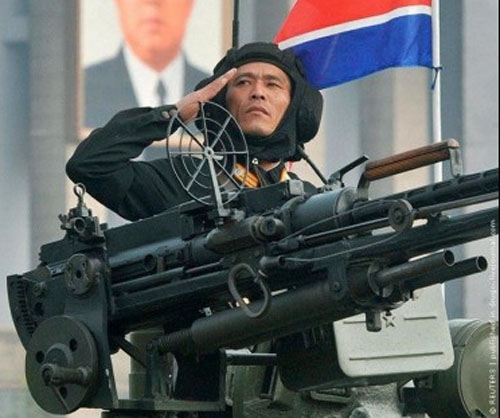 |
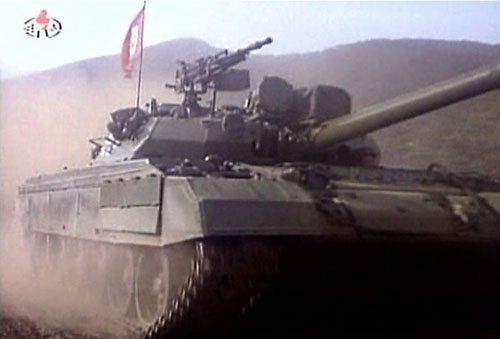 |
|
| Chonma-216 on move, from some videos. Left: here we can see the profile of the tank; it is lacking the front part of the fenders. Left down: an interesting detail of the front armour and of the smoke mortars with their wiring. The image shows also that the spaces between the cans are covered by thin plates, hiding their handles and the fuel piping. What we see are covers protecting and hiding the cans and their piping, as on T-72. Below: here we see some details of the rear. Note the rear can, whose side and piping is visible under its cover. |
|
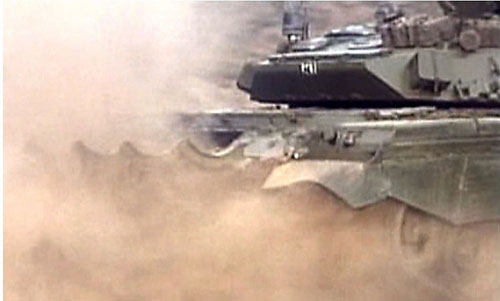 |
|
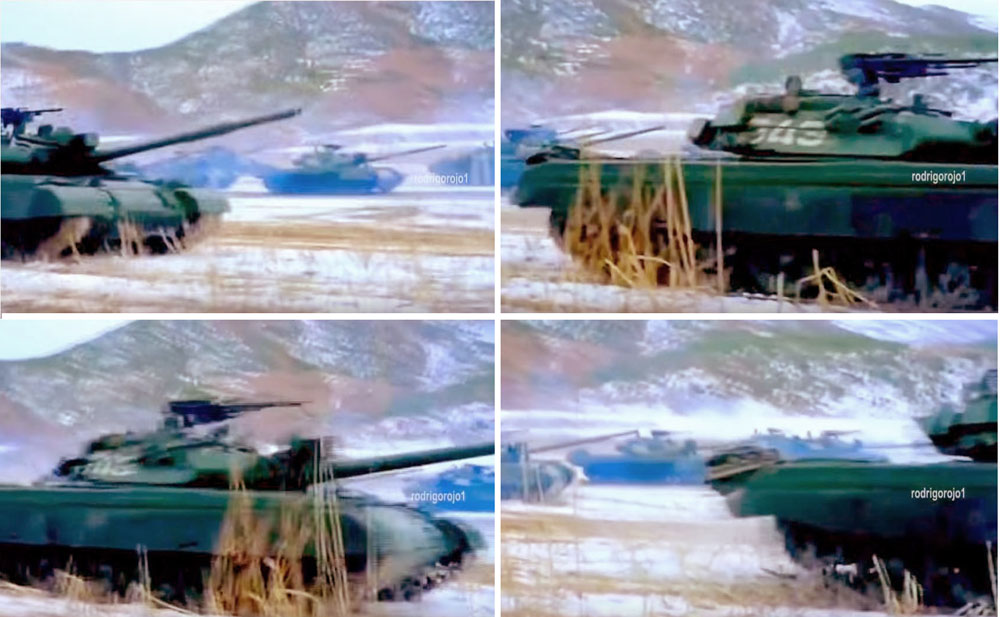 |
|
Above: four blurred screenshots of a Chonma-216 that can be useful to trace a profile. Note that the rear racks are not utilized for fuel drums, but for some other load. Note that the footsteps on the side skirts can be 2 or 3, and change position from tank to tank. Left: an apparently good profile of Pokpung-ho II (Chonma-216). Seems that no any 4-views scale drawing is available. |
|
 |
An image of a Chonma-216 from an unusual perspective. |
| The version of Chonma-215 and 216 (as this one) armed with additional
2 AT-5 Spandrel launchers fitted above
the turret's roof and 1 SA-16 MANPADS
fitted on the turret rear. Some of these vehicles have an awesome camouflage made with sand and brown over the olive green background. |
|
|
|
|
Other images of these awesome tanks. |
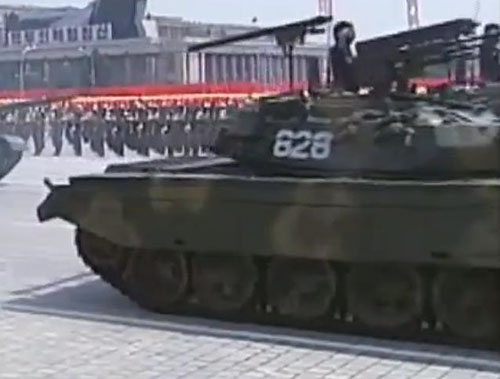 |
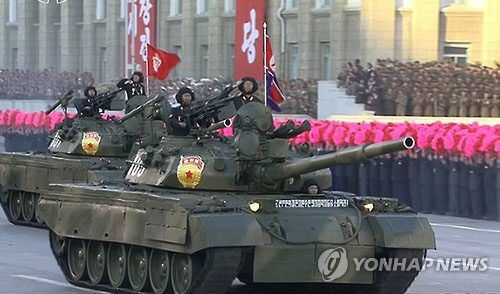 |
Above: Although not sharp, this image shows something of the rear fenders and deck of this -216. Aside: a Chonma-216 probably during the parade of 2015. All the tanks wore an emblem (unclear if painted or adhesive) on both sides of the turret. The tank features a cleaner camouflage than the previous images.
|
|
In February 2016, the North Korean TV showed images of the test of a new antitank missile, Bulsae-3. The target was a Chonma-216, easily recognizable for 6 road wheels and the smoke dischargers. The tank was destroyed. Apart for the test, at present time this is the only available image without side skirts, and allows to see that the tracks are supported by 3 rollers on each side. The second image shows some details of the turret and hull after the blast. |